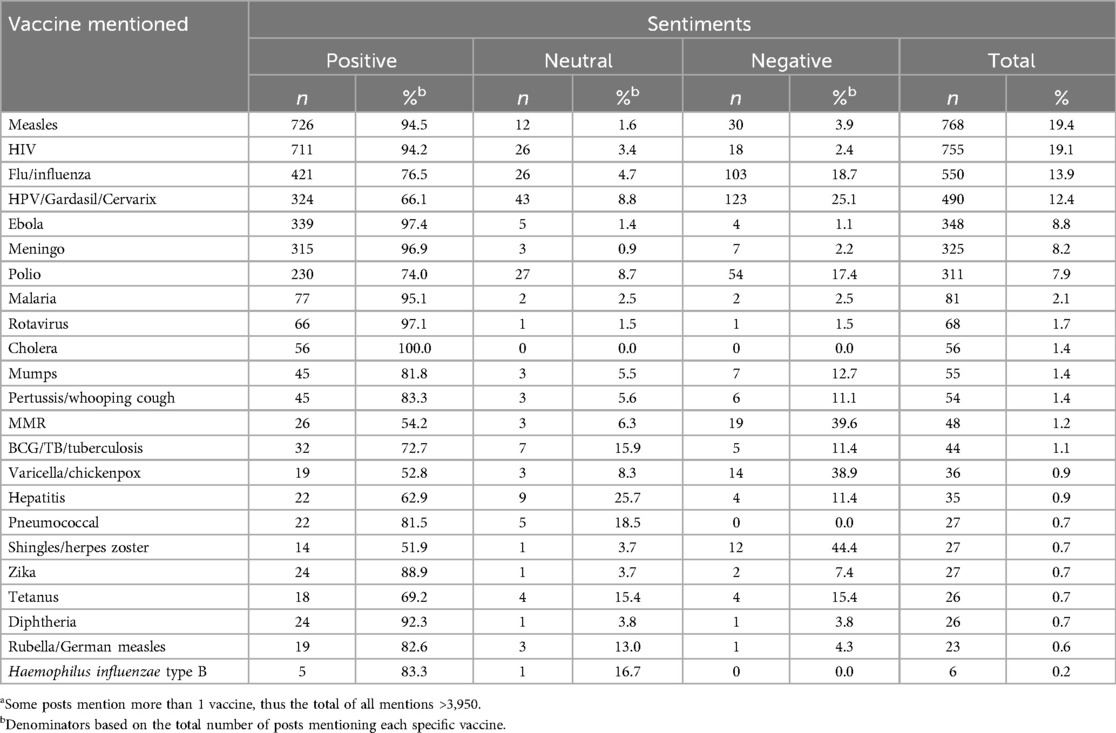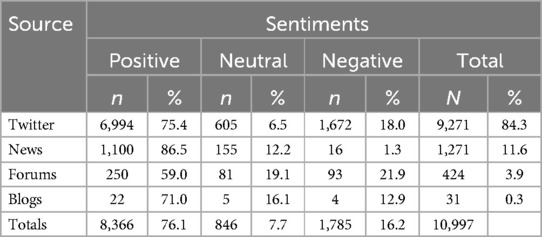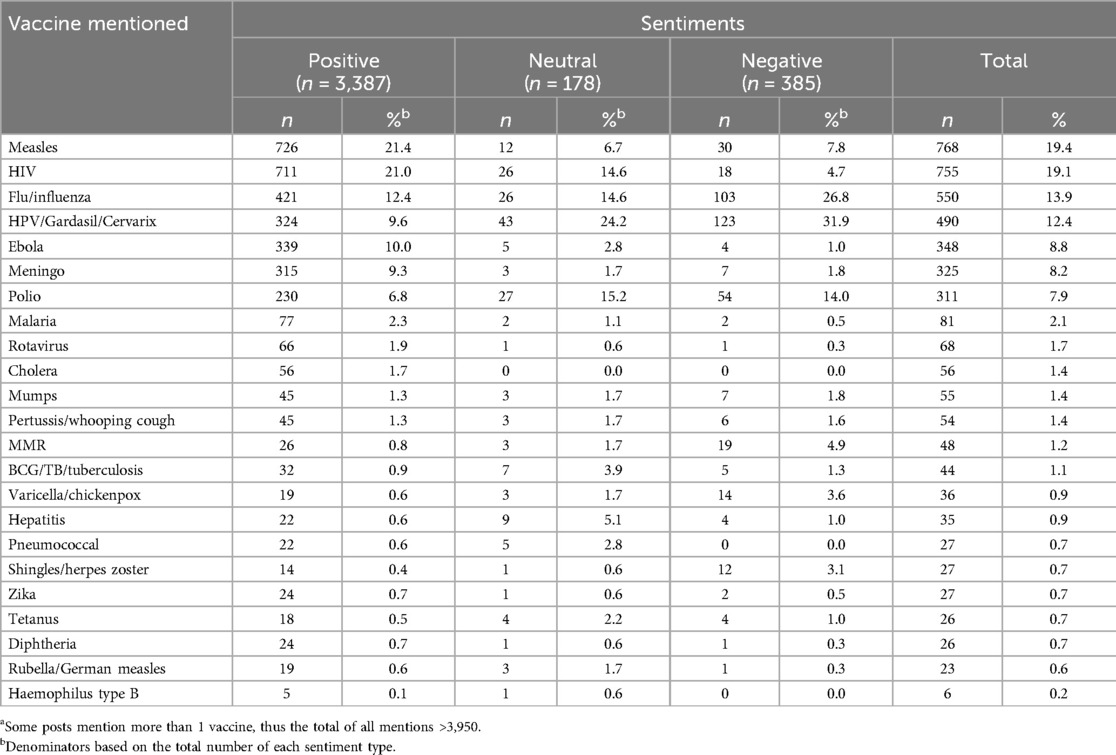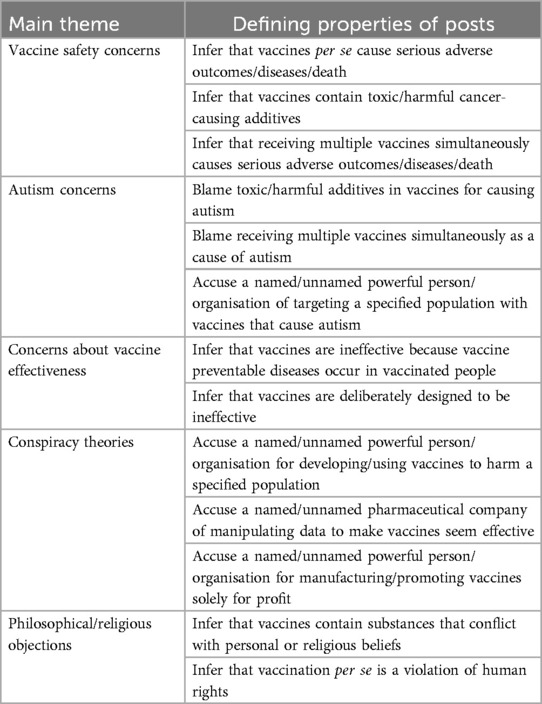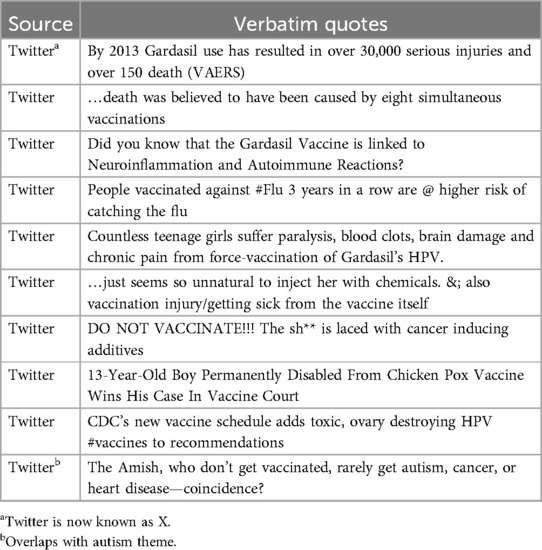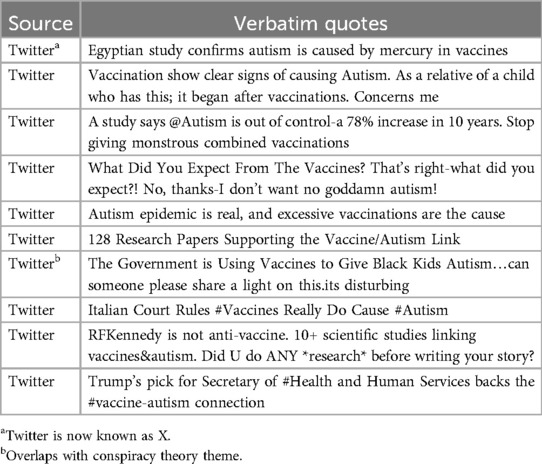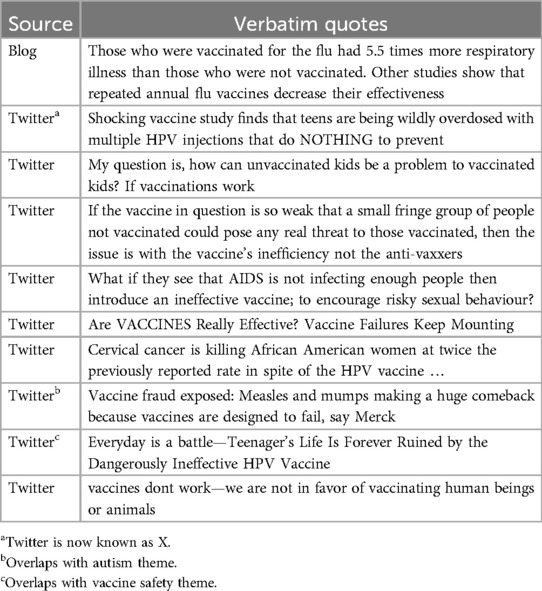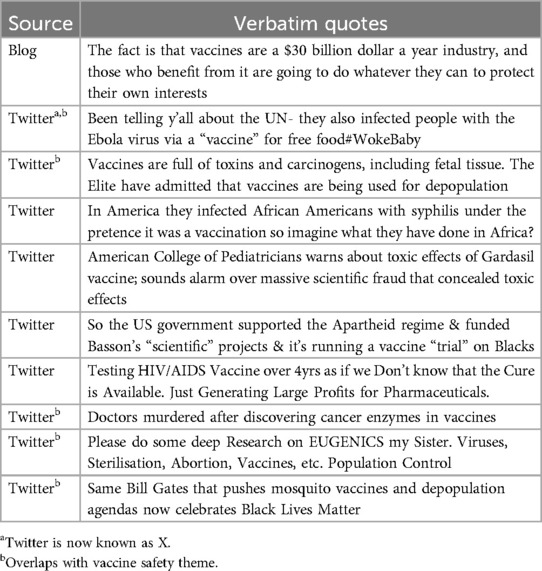- 1Department of Public Health Pharmacy and Management, School of Pharmacy, Sefako Makgatho Health Sciences University, Pretoria, South Africa
- 2South African Vaccination and Immunisation Centre, Sefako Makgatho Health Sciences University, Pretoria, South Africa
- 3Department of Virology, School of Medicine, Sefako Makgatho Health Sciences University, Pretoria, South Africa,
Introduction: During the pre-pandemic era, negative vaccine sentiments did not feature in South African publications reporting on infant vaccination uptake. In contrast, vaccine hesitancy is an established driver of suboptimal COVID-19 vaccine uptake in South Africa, suggesting that the COVID-19 pandemic increased vaccine hesitancy in South Africa. This study used data from a social media tracking project to investigate vaccine sentiment expressed on South African social media platforms in the pre-pandemic era.
Methods: This mixed-methods study analysed South African social media [Twitter (now X); online news forums; microblogs] posts mentioning vaccine-related words from 1 December 2016–31 May 2017. Content analysis was used to assign vaccine sentiment, and thereafter a step-wise thematic content analysis of negative sentiment posts was conducted using NVivo12®.
Results: Of 10,997 posts about human vaccines, 16.2% expressed negative vaccine sentiments. Specific vaccines were discussed in 35.9% of posts, with human papillomavirus (HPV) vaccines attracting the most negative sentiments (31.9% of all negative posts). The majority of negative posts included links to articles emanating from other countries, predominantly the USA. Five themes were identified: Vaccine safety; autism; vaccine effectiveness; conspiracy theories; and philosophical/religious objections.
Discussion: Relatively high levels of pre-existing negative sentiments toward vaccines were expressed in the pre-pandemic era, with HPV vaccines attracting the most negative comments. These results provide a baseline for comparison to post-pandemic social media studies and may prove useful for measuring the impact in South Africa of global policies introduced to limit the spread of vaccine mis- and disinformation.
1 Introduction
In 2018, the rapid dissemination of vaccine mis- and disinformation, spread mainly through social media, was identified through research conducted by the Vaccine Confidence Project™ (https://www.vaccineconfidence.org/) as a major threat to global public health (1). Then in 2019, based on the alarming increase in outbreaks of vaccine-preventable diseases (VPDs) that had previously been eliminated in mainly high-income countries, the World Health Organization (WHO) declared vaccine hesitancy, defined as “the reluctance or refusal to vaccinate despite the availability of vaccines” as one of the top 10 threats to global public health (2). However, it was in 2020/2021 that vaccine hesitancy captured the imagination of the general public globally, as a result of the social media-driven “infodemic” that undermined efforts to control the coronavirus disease 2019 (COVID-19) pandemic (3–5).
In South Africa, infant vaccination services are provided free of charge in the public sector (6). However, 16% of the South African population access healthcare, including vaccination services, at high cost through the private sector (7). Negative sentiments toward vaccines did not often feature prominently in published South African surveys and qualitative research conducted on vaccination uptake in the pre-pandemic era. When it did feature prominently as a driver of low vaccination coverage, it was largely confined to research on the human papillomavirus (HPV) vaccine (8–12), most of which was conducted online (9, 11, 12). While one study reported that 6.7% of vaccination programme managers perceived vaccine hesitancy (phrased as “resistance from parents and anti-immunisation rumours”) as a key challenge preventing the achievement of high routine infant vaccination coverage (13), there was little or no evidence of negative sentiments toward vaccines from face-to-face household vaccination coverage surveys (6, 14–18). This evidence ranged from 0.4% (1/276) of participants who “have no faith in vaccines” (1.5% of the under-vaccinated) (14) to 3.1% (116/3,705) of participants who “lack motivation” to vaccinate their children (13.5% of the under-vaccinated) (17). However, none of these face-to-face household vaccine coverage surveys included caregivers living in exclusive communities (i.e., high property-value walled or gated communities and security complexes (19), as in-person access to these communities has proven to be impossible (6, 14). It is highly likely that these exclusive communities have higher rates of internet access than low-income communities (14). While data on the extent of South Africans living in gated communities are lacking, it is also highly likely that the 16% of South Africans who can afford private healthcare (7), can afford internet access. Taken together, this may explain discrepancies in reports of negative vaccine sentiment between online surveys and face-to-face surveys conducted in South Africa during the pre-pandemic era. In addition, while all surveys inherently suffer from bias, surveys using face-to-face data collection have been shown to suffer more from social desirability bias than online surveys (20), which may result in under-reporting of vaccine hesitancy in household surveys.
In contrast to the pre-pandemic era, negative sentiments toward COVID-19 vaccines featured in all South African COVID-19 vaccine acceptance and uptake surveys (21–26), and in multinational vaccine confidence surveys that include South Africa (27–30). There is also global evidence including from South Africa, suggesting that negative COVID-19 vaccine sentiments have undermined confidence in vaccines routinely received during childhood (27, 28, 31). For example, the United Nations Children's Fund estimates that the COVID-19 pandemic resulted in a 30% decline in confidence in childhood vaccines in South Africa, with only 62% of the population being confident that vaccines are important for children (31), suggesting that the COVID-19 pandemic dramatically increased vaccine hesitancy in South Africa. In the absence of published evidence of vaccine sentiment expressed on South African social media platforms before the pandemic, we used data from a social media tracking project conducted to investigate vaccine sentiment expressed on South African social media platforms in the pre-pandemic era. This baseline is essential for measuring the impact in South Africa of global policies introduced by social media platforms during the pandemic, to limit the spread of vaccine mis- and disinformation (4). It can also be used to assess the impact of post-pandemic enhanced vaccine communication strategies aimed at increasing public confidence in, and uptake of, routine childhood vaccines.
2 Materials and methods
2.1 Study design and study population
This mixed-methods study was based on social media posts emanating from South African IP addresses. Data were collected from 1 December 2016 to 31 May 2017, using Pulsar® software, a commercially available online “social listening” tool (https://www.pulsarplatform.com/). Facebook was excluded from the project because of its privacy rules; thus, the project was confined to Twitter (now X), online news forums and other microblogs. No sampling was conducted; all posts with South African IP addresses in the public domain were included. South Africa has 11 official written languages (sign language is the 12th official language); however, the search terms were confined to keywords in English and Afrikaans, based on previous findings of no hits when searching for Internet content using the terms for vaccination in the other official languages (32). This search strategy is supported by previous research on South Africans whose home languages were isiZulu, siSwati, Sepedi, Tshivenda, and Xitsonga, which reported that “most of the respondents prefer using the English language on social media” (33). Because South African social media users tend to use a mixture of languages (33), language was categorised according to the predominant language used in each post. The following Boolean search string was used: Vaccination OR vaccinate OR vaccine OR vaccinations OR vaccinates OR vaccines OR vaccinated OR #vaccination OR #vaccinate OR #vaccine OR #vaccinations OR #vaccinates OR #vaccines OR #vaccinated OR inenting OR entstof OR entstowwe OR inentings OR ingeënt OR #ingeënt OR #inenting OR #entstof OR #entstowwe OR #inentings.
2.2 Data collection and sentiment coding
While Pulsar® software is designed to code sentiment as positive, neutral or negative, during piloting it was decided that given the complexity of vaccine hesitancy that resulted in frequent misclassification, vaccine sentiment assignments should be manually recoded to ensure validity. Thus, for this study, vaccine sentiment was checked and recoded in two phases, using a content analysis approach associated with qualitative research to generate quantifiable data. In the first phase, MMM and a research assistant reviewed each post, and manually changed the software-assigned sentiment if they both agreed on the change. Where there was disagreement between the two, JCM made the decision on sentiment allocation. In the second phase, RJB reviewed all posts, and where there was disagreement with the sentiments allocated in the first phase, ZI made the final decision. In total, 85.4% (9,386/10,997) of the sentiments were manually reclassified. Of all posts classified as positive, negative and neutral after validation, respectively 88.5% (7,400/8,366), 70.1% (1,252/1,785) and 86.8% (734/846) had been manually reclassified. “Negative” was assigned to any post suggesting that vaccination may or should be delayed or refused (i.e., any concerns about vaccination, such as concerns about or questioning of vaccine safety, vaccine ingredients, vaccine effectiveness, or any other concern that suggested that vaccination may or should be delayed or refused). “Positive” was assigned to any post that promoted vaccination in any way including optimism about new vaccines under development. “Neutral” was assigned to any post where no clear tone or position could be discerned (i.e., posts that neither promoted nor cast doubt on the value of vaccination). In addition, data were collected on the source of the posts, and the contents of the posts.
2.3 Quantitative data analysis
Data were downloaded from Pulsar® in Microsoft Excel® (Microsoft Office, USA) format, and imported to Epi Info™ 7.2.5.0 (Centers for Disease Control and Prevention, USA) for descriptive statistical analysis. Furthermore, the Microsoft Excel data were also imported into Microsoft Access® (Microsoft Office, USA) for analysis of the posts to identify any vaccines that were mentioned. For each vaccine, an Access query was run using the words listed in Table 1 as search criteria with an asterisk on either side (i.e., the Access query format used to identify a word anywhere within the text).
2.4 Qualitative data analysis of negative sentiment
The contents of all posts with negative sentiment codes were imported into NVivo12®, a qualitative data analysis computer software package. A step-wise thematic content analysis of the data was conducted by MMM and JCM. Coding of the data commenced, following detailed reading of the posts in NVivo. Data were coded into nodes by MMM and re-coded by JCM to ensure the trustworthiness of the coding process. Continuous discussions between the two authors followed until consensus was reached about the coding, which further ensured the dependability of the data. Nodes were grouped into categories and sub-categories. Categories were then linked to one another forming overarching themes with sub-themes that depicted shared anti-vaccination sentiments.
2.5 Ethical considerations
This study was approved by the Sefako Makgatho University Research Ethics Committee (SMUREC/P/60/2018:PG) prior to data collection. All data were available in the public domain, and where personal identifiers of the social media account holders were evident, these data were neither collected nor reported in the results.
3 Results
3.1 Overall description of vaccine-related posts
A total of 11,111 posts mentioning a keyword were collected during the study period. After removing posts referring to animal vaccinations and the rock band “The Vaccines”, 10,997 records remained. Of these, 97.9% (10,766/10,997) were written mainly in English. The vast majority of the posts were on Twitter (now X), and expressed positive sentiments toward vaccines. See Table 2 for further details.
Of all posts, 35.9% (3,950/10,997) mentioned one or more vaccine/s listed in Table 1. Of the posts mentioning specific vaccines, 85.7% (3,387/3,950) were positive, 4.5% (178/3,950) were neutral, and 9.7% (385/3,950) were negative. Vaccines which attracted the most positive sentiments were those against measles and human immunodeficiency virus (HIV) infection, with respectively 21.4% (726/3,387) and 21.0% (711/3,387) of vaccine-specific positive posts. Vaccines which attracted the most negative sentiments were those against HPV infection and influenza, with respectively 31.9% (123/385) and 26.8% (103/385) of vaccine-specific negative posts. See Table 3 for further details.
3.2 Results of thematic analysis of negative sentiments
The majority of posts expressing negative sentiments included links to articles emanating from other countries, predominantly the USA. However, data analysis was not conducted on these articles, thus the results reported here are confined to posts emanating from South Africa. Thematic analysis generated five overarching themes which are listed in Table 4 together with their defining properties. Where sub-themes emerged within some of the themes, these sometimes overlapped with other sub-themes within the same theme or other themes.
3.2.1 Vaccine safety concerns
The overarching theme on concerns about vaccine safety included various sub-themes. One sub-theme centred around the perception that vaccines cause diseases, including autoimmune disorders and the diseases against which they are supposed to protect. In particular, it was believed that many children have died from HPV vaccination, and that the HPV vaccine causes autoimmune diseases, ovarian failure, myocarditis, clotting and severe pain. It was also believed that the HPV vaccine causes cervical cancer, and the influenza vaccine causes influenza. Within this sub-theme was the common belief that vaccines enhance the spread of infectious diseases. Another sub-theme was that vaccination results in the development of adverse effects affecting the brain. In addition to autism, these included obsessive compulsive disorder, anorexia nervosa, a host of other brain and neurological disorders and death, with the HPV vaccine being commonly blamed for convulsions, neuroinflammation, encephalopathy, brain damage and paralysis. A third sub-theme centred on the belief that vaccines contain additives which predispose recipients to developing cancer. This sub-theme was linked to a fourth sub-theme centred on vaccine additives which were often labelled as “harmful” and “toxic”, particularly regarding HPV vaccines. Mentions of ingredients such as the mercury-based preservative thimerosal (also referred to as mercury in many posts) were common, with many believing that mercury in vaccines is responsible for causing neurological disorders. Another additive, aluminium, was implicated in causing genetic changes that are passed on from one generation to the next. See Table 5 for examples of these posts.
3.2.2 Autism concerns
Linked to and overlapping with the vaccine safety and conspiracy theory themes, but emerging as a theme on its own, was the belief that vaccines cause autism. Several posts overlapped with the vaccine safety sub-theme of brain disorders, since they conveyed the belief that vaccine additives such as mercury resulted in the development of autism and autism spectrum disorders, while others conveyed the belief that the “excessive” quantity of vaccines are responsible. A few posts were linked to the conspiracy theory theme, suggesting that vaccines were a government plot to give Black children autism. Some posts were about the belief that a loved one developed autism after vaccination, while many made reference to claims by former USA President Donald Trump, where he had expressed his belief in a possible link between what he termed “monstrous combined vaccines” and autism. See Table 6 for examples of these posts.
3.2.3 Concerns about vaccine effectiveness
The anti-vaccination conversational landscape on the social media platforms in this study showed a general lack of confidence in the effectiveness of vaccines. Several posts conveyed doubts about vaccine effectiveness, with the HPV vaccine being called “dangerously ineffective”, and questioned why cases of vaccine-preventable diseases still occurred in people who had been vaccinated. Examples include contracting meningitis despite receiving the meningitis vaccine, and measles and mumps outbreaks where some cases had been vaccinated. Some posts expressed views that were linked to conspiracy theories. For example, one post hypothesised that the HIV vaccine was purposefully designed to be ineffective and was meant to encourage risky sexual behaviour. See Table 7 for examples of these posts.
3.2.4 Conspiracy theories
Conspiracy theories around government organisations, health boards and the pharmaceutical industry emerged as a recurring theme. Health regulatory boards such as the CDC and the USA Food and Drug Administration were often accused of withholding information on vaccine adverse effects and instead overinflating positive vaccine safety information. Many posts centred on racial motives, with phrases being used such as “germ warfare against black kids,” “depopulate the world,” “biological warfare” and “medical genocide” targeted at Africans. Some posts centred on Bill Gates, suggesting that he is planning on introducing “a new deadly vaccine” to South Africa, and that he is funding vaccination programmes “which would lead to pandemics”. Conspiracy theories around pharmaceutical companies centred on the common belief that vaccine manufacturing companies do so primarily for financial gain. These posts included calling vaccine programmes a “toxic scam so Big Pharma can make money,” and the opinion that pharmaceutical companies manipulate scientific data to make vaccines seem effective in order to make profit. See Table 8 for examples of these posts.
3.2.5 Philosophical/religious objections
The belief that vaccines contain substances that conflict with personal or religious beliefs, emerged from three sub-themes within the overarching theme of philosophical/religious objections. One sub-theme centred on the belief that vaccines contain foetal tissue, which raised concerns over the use of aborted babies in vaccine preparations. This sub-theme included conversations about refusing vaccination because of religious beliefs that are against abortion. The second sub-theme centred on the use of porcine products in vaccines, which conflicts with religious beliefs that are against the ingestion of pork. The third sub-theme centred on any type of animal products being used to manufacture vaccines, where vegans expressed concerns over the use of animal-based additives in vaccine formulations, while animal rights activists perceived the use of animal products as an act of cruelty against animals. A fourth sub-theme centred on mandatory vaccination being perceived as a violation of human rights, with examples from other countries being discussed. See Table 9 for examples of these posts.
4 Discussion
To the best of our knowledge, this study is the first to report on public sentiments about a broad range of vaccines expressed on South African social media platforms with unrestricted data access, providing evidence of relatively high levels of pre-existing negative sentiments toward vaccines in the pre-pandemic era. Our finding that more than 80% of vaccine-related posts were on Twitter is supported by a multi-national (15 countries, including South Africa) study on vaccination of pregnant women conducted from 1 November 2018–30 April 2019, where almost 90% of social media posts were on Twitter (34). However, it must be borne in mind that at the time of our study, Twitter was used by only 25% of South African social media users (35). Because our search was limited by social media platforms' privacy rules (a limitation that applies to all “social listening” projects, including the multi-national study on pregnant women) and the capabilities of Pulsar® software, Facebook, YouTube and Instagram (used by 49%, 47% and 25% of South African social media users, respectively) were excluded from our study. Our finding that 9.7% of posts mentioning specific vaccines expressed negative sentiments is in line with the South African results of this multinational study, which reported that 8.1% of South African posts about maternal vaccination were negative (34). However, our finding that 16.2% of posts overall expressed negative sentiments indicates that hesitancy toward vaccines is often more general and not confined to any specific vaccine, because of a lack of trust in health authorities, which has been identified as a major driver of vaccine hesitancy (3). This may help explain why, in the post-pandemic era, COVID-19 vaccine hesitancy may also negatively impact the uptake of infant and other vaccines that were accepted without questioning in the pre-pandemic era, as previously suggested (27, 28, 31).
The multinational study of maternal vaccination reported South Africa as one of three countries (South Korea and Germany being the other two) most affected by “discouraging” tweets originating in the USA (34), which supports our finding of the predominance of links to anti-vaccination articles emanating from the USA. This observation also echoes findings of an earlier study on anti-vaccination lobbying on the South African internet, which reported that from 2011–2013, 71.6% of anti-vaccination content originated from the USA alone, while a further 6.0% originated from both the USA and the United Kingdom (UK) (32).
The social media vaccine discourse during our study period was dominated by four vaccines. Unfortunately, sub-optimal vaccination coverage had resulted in a major measles outbreak in South Africa throughout 2017, at the same time that our study was conducted (36). This may explain why 19.4% of posts were about the measles vaccine, while the finding that almost 95% of measles vaccine-related posts were positive may be explained by the social media campaigns promoting measles vaccination conducted by the South African National Department of Health (NDoH) and Provincial Departments of Health (DoH) and their partners throughout the outbreak. Following close behind, the HIV vaccine was the topic of 19.1% of posts, with almost 95% being positive. This was most likely because a highly publicised clinical trial to test the safety and efficacy of an experimental HIV vaccine was launched just before we started our study, with participants being recruited throughout the duration of our study (37). Only two other vaccines were discussed in more than 10% of posts in our study—those against influenza (13.9% of posts) and HPV (12.4% of posts). Their relative prominence during the period when our study was conducted is most likely because every year (a) the annual influenza vaccination campaigns start in March (38), and (b) annual school-based HPV vaccination campaigns are held in February and March. Thus, social mobilisation campaigns conducted by the NDoH, Provincial DoH and their partners using all types of media, including social media, promote these vaccines during February and March every year, which also explains why the majority of comments about these vaccines were positive, despite both vaccines attracting the largest numbers of negative comments. This latter finding was unsurprising, given that those expressing negative sentiments in our study relied heavily on articles predominantly emanating from the USA, where vaccine hesitancy toward these two vaccines has been found to be higher than toward routine childhood vaccines (39–41).
Except for the measles vaccine, all other vaccines given routinely during early childhood were discussed in less than 10% of posts. However, negative sentiments were expressed in more than 10% of posts discussing most of these vaccines, namely the combined measles mumps rubella vaccine (MMR) (39.6% negative); and those against chickenpox (38.9% negative), polio (17.4% negative), tetanus (15.4% negative), mumps (12.7% negative), hepatitis (11.4% negative), tuberculosis (11.4% negative) and pertussis (11.1% negative). Of interest is that MMR and varicella vaccines against chickenpox are only available through the South African private sector. Furthermore, caregivers utilising private sector healthcare services represent only 16% of the South African population, and are much more affluent than the 84% utilising the public sector (7). Thus, our finding that almost 40% of posts about these two private sector vaccines were negative supports the suggestion made in the introduction, that online and social media research in South Africa is more likely to report higher levels of vaccine hesitancy than face-to-face household surveys, since relatively wealthy gated communities are seldom accessed during these surveys. In addition, the extent of negative sentiment expressed towards MMR was expected, because the discredited claim that MMR causes autism continues to circulate globally (42) and has been evident on South African webpages since at least 2011 (32). This claim originated from unethical, fraudulent, discredited research published in 1998 and subsequently retracted in 2010 (43), authored by a doctor from the UK who has since emerged as a leader of the modern anti-vaccination movement in the USA (44). Also, at the time our study was conducted, a tetravalent vaccine against MMR and varicella (MMRV) was available in the South African private sector. It is thus possible that the varicella vaccine may have become associated with MMR in public discourse, thus attracting a relatively large proportion of negative sentiment.
Our identification of vaccine safety concerns as a major theme was not unexpected. Since the first vaccine against smallpox was introduced in the early 19th century, vaccine safety has always been a major theme driving vaccine hesitancy globally (42, 45), with the Wellcome Global Monitor 2018 reporting that 7% of over 140,000 participants from 140 countries somewhat or strongly disagreed with the statement “vaccines are safe”, while 9% of South Africans disagreed (46). Vaccine safety concerns have also featured in pre-pandemic South African studies reporting on online content or reasons for not vaccinating, with three of these focusing on HPV vaccination, which since 2014 have been available free of charge to girls aged ≥9 years attending South African public sector schools (9–11). First, an online survey of caregivers of girls attending private sector schools in 2018 reported that only 19.4% of age-eligible girls had received ≥1 HPV vaccine dose, with 28.8% of caregivers of unvaccinated girls being concerned about vaccine safety (11). Second, a hard-copy self-administered questionnaire-based survey of caregivers of girls attending public sector schools in a district of South Africa in 2019 where ≥1dose HPV vaccination coverage was found to be 67.1%, reported that 31.9% of caregivers of unvaccinated girls were concerned about vaccine safety, while 15.1% had heard rumours of serious adverse events following immunisation [AEFI] with the HPV vaccine (10). Third, an analysis of comments in response to a February 2019 announcement on the Western Cape DoH's Facebook page about the commencement of the annual HPV vaccination campaign, identified 33% as negative, with vaccine safety concerns being a major driver (9). Only one study was based on infant vaccination, which reported that 95% of websites publishing anti-vaccination content from 2011–2013 claimed that vaccines are not safe, while 73.1% claimed that the risk of AEFI was higher than the risk of the disease itself (32). The multi-national study of 15 countries mentioned previously, was a discourse analysis based on social media posts regarding maternal vaccination (34). This study reported that South Africa was one of three countries (USA and Italy being the other two) expressing safety concerns about maternal vaccination, with posts reflecting fear and anger related to the perception that maternal vaccination results in foetal death and various diseases (34).
While autism concerns related to vaccination are a type of vaccine safety concern, autism concerns emerged as a major theme in our study, with some posts also expressing conspiracy theories. For the same reason we expected a high proportion of negative sentiment towards MMR, we were unsurprised that autism concerns emerged as a major theme in our study. However, the MMR did not emerge within this theme in our study, where vaccines in general (particularly “excessive” quantities of vaccines, combined vaccines and mercury in vaccines) were blamed for causing autism. This finding is supported by the multinational study on maternal vaccination, where autism was linked to all maternal vaccinations, with South Africa being one of three countries (USA and Italy being the other two) expressing these concerns (34).
Similar to vaccine safety concerns, concerns about vaccine effectiveness also have their roots in objections to the introduction of smallpox vaccination in the 19th century. At that time, causal analysis using inferential statistical methods had not yet been invented, and Alfred Russel Wallace, a scientist who, along with Charles Darwin, had discovered the theory of evolution, based his stance against mandatory smallpox vaccination on the lack of scientific evidence of its effectiveness (45). While actuarial statistical analysis of life tables and smallpox mortality rates was used by both pro- and anti-vaccination scientists at that time, his interpretation of the data led him to conclude that smallpox mortality rates increased as smallpox vaccination coverage increased, while pro-vaccination scientists concluded the exact opposite (45). Since that time, so-called science-based claims of lack of vaccine effectiveness are often based on inappropriate simplistic statistical analysis, despite overwhelming evidence of the effectiveness of vaccines from studies using appropriate inferential statistical analysis (32). The Wellcome Global Monitor 2018 reported that 5% of participants globally somewhat or strongly disagreed with the statement “vaccines are effective”, while 11% of South Africans disagreed (46), perhaps because South Africans are more affected by vaccine misinformation originating in other countries, as shown elsewhere (34). The emergence of this claim as a major theme in our study is also in agreement with previous South African internet-based and social media research, with 65.7% of South African websites publishing anti-vaccination content from 2011–2013 making this claim (32), while the perception that there is no evidence of HPV vaccination preventing cervical cancer was expressed by Facebook users in response to the announcement of the 2019 HPV vaccination campaign (9). Similarly, 4.4% and 10.5% of caregivers of unvaccinated age-eligible girls attending private and public sector schools respectively in South Africa, perceived that the HPV vaccine was ineffective (10, 11).
The spread of conspiracy theories fuelled vaccine hesitancy globally long before the COVID-19 pandemic (4, 42, 47) and featured on South African webpages since at least 2011 (32). While conspiracy theories on South African webpages discrediting vaccines from 2011–2013 focused on the profit motive of pharmaceutical companies (32), a much broader range of conspiracy theories were mentioned within the theme that emerged from our study. Many of these posts overlapped with the vaccine safety concern theme and reflected distrust in government, the pharmaceutical industry, and local and global health authorities. Furthermore, posts centering on racial motives against Africans reflected distrust emanating from past and present social injustices inflicted on Black South Africans. These findings provide further evidence that social, cultural, historical, institutional and political factors unrelated to vaccination are driving vaccine hesitancy globally, as previously posited by others (4, 47).
Philosophical and religious objections to vaccination are also rooted in the introduction of smallpox vaccination in the 19th century, in response to laws enforcing mandatory vaccination. Widespread anti-vaccination lobbying resulted in a law being passed in the UK in 1898, allowing for exemptions based on conscientious objection to vaccination (45). In the USA, even in states where smallpox vaccination was not mandatory, conscientious objections to vaccination centred on the violation of civil rights and personal freedoms, including religious freedom (48). It has previously been shown that vaccination also poses ethical and religious concerns for some sectors of South African society (32), which supports our findings of negative sentiments toward vaccination being expressed by vegans, animal rights activists and those with religious beliefs that conflict with vaccination. Also, despite vaccination not being mandatory in South Africa, mandatory vaccination as a violation of human rights emerged as a sub-theme in our study, which again supports previous findings of the influence on South African social media users exerted by negative posts emanating from the USA (34).
5 Limitations
Like most online “social listening” platforms, Pulsar® uses IP addresses to geolocate the origin of content. However, the global use of virtual private networks (VPNs), including in South Africa and the rest of Africa (https://www.cmcnetworks.com/africa-vpn-services.html), limits the validity of these data. This is because VPN users from outside South Africa who used South African VPNs, would have been included in the dataset. Also, South Africans using VPNs from other countries would have been excluded from the dataset. This is an unavoidable limitation which to the best of our knowledge is experienced by all researchers engaged in online “social listening” projects.
Six months may not have been long enough to fully establish pre-pandemic public sentiment, but given the time-consuming and labour-intensive methods used for analysing the data where more than 85% of software-assigned sentiments had to be changed, it was necessary to confine our study to a six-month period. During this time, social media was used by the NDoH to promote measles, HPV and influenza vaccines, thus it is possible that there may have been an over-representation of positive sentiments being expressed toward these vaccines in our study.
The finding that most posts were predominantly written in English was expected, since it has been shown that most South African indigenous language speaking social media users prefer to post in English, interspersed with words in indigenous languages (33). While we did not record which languages were mixed with English in each post, switching between languages when speaking is common in South Africa, which is a multilingual country where most people are able to speak more than one language (33). However, it is possible that we may have missed some posts where indigenous language words instead of vaccine were used, thus we acknowledge this as a possible limitation, although these words were not found in previous South African online research (32).
Since our study was limited by social media platforms' privacy rules and the capabilities of Pulsar® software, our results are biased towards the views of South African social media users who were active on Twitter at the time of our study. Since there is evidence of distinct differences in the socio-demographic profiles of users of different social media platforms in the USA (49), it is likely that the same is true for South African social media users. While data from South Africa are lacking, it can be assumed that this is the most important limitation of our study.
6 Conclusions
This study provides pre-pandemic evidence of a relatively high proportion of vaccine hesitancy being expressed on South African social media, with 16.2% of posts during the study period expressing negative sentiments toward vaccination, including vaccines used for routine childhood immunisation, with negative sentiment proportions reaching almost 40% for some infant vaccines, while HPV vaccines attracted the most negative sentiments overall. The Vaccine Confidence Project™ previously identified social media monitoring as a method for early detection of waning levels of public confidence in vaccines, allowing health authorities to respond with timely, targeted and appropriate interventions (5). While the methods we used in our study were time-consuming, a scoping review of vaccine-related social media monitoring methods conducted in 2018, identified 20 studies using automated monitoring tools (50). While further research is needed to identify the most accurate and affordable automated tool to use in our setting, the results of this study can be used as a baseline against which future studies can be compared.
Data availability statement
The original contributions presented in the study are included in the article/Supplementary Material, further inquiries can be directed to the corresponding author.
Author contributions
MM: Data curation, Formal analysis, Investigation, Project administration, Validation, Visualization, Writing – original draft. RB: Conceptualization, Funding acquisition, Methodology, Supervision, Validation, Visualization, Writing – review & editing. ZI: Validation, Visualization, Writing – review & editing. JM: Formal analysis, Methodology, Supervision, Validation, Visualization, Writing – review & editing.
Funding
The author(s) declare that financial support was received for the research and/or publication of this article. This research was funded by the National Research Foundation of South Africa (Reference: CPRR150701122450; Grant No: 98959). SAVIC receives unrestricted educational grants from the vaccine industry.
Acknowledgments
The authors thank NG Burnett for assisting with the manual recoding of the software-assigned vaccine sentiment in the first phase of sentiment coding.
Conflict of interest
The authors declare that the research was conducted in the absence of any commercial or financial relationships that could be construed as a potential conflict of interest.
The author(s) declared that they were an editorial board member of Frontiers, at the time of submission. This had no impact on the peer review process and the final decision.
Generative AI statement
The author(s) declare that no Generative AI was used in the creation of this manuscript.
Publisher's note
All claims expressed in this article are solely those of the authors and do not necessarily represent those of their affiliated organizations, or those of the publisher, the editors and the reviewers. Any product that may be evaluated in this article, or claim that may be made by its manufacturer, is not guaranteed or endorsed by the publisher.
References
1. Larson HJ. The biggest pandemic risk? Viral misinformation. Nature. (2018) 562:309. doi: 10.1038/d41586-018-07034-4
2. World Health Organization (WHO). Ten Threats to Global Health in 2019. Available at: https://www.who.int/news-room/spotlight/ten-threats-to-global-health-in-2019 (Accessed December 5, 2023).
3. Pitts PJ, Poland GA. Trust and science: public health’s home field advantage in addressing vaccine hesitancy and improving immunization rates. Vaccine. (2023) 41:5483–5. doi: 10.1016/j.vaccine.2023.08.003
4. Pertwee E, Simas C, Larson HJ. An epidemic of uncertainty: rumors, conspiracy theories and vaccine hesitancy. Nat Med. (2022) 28:456–9. doi: 10.1038/s41591-022-01728-z
5. Larson HJ, Lin L, Goble R. Vaccines and the social amplification of risk. Risk Anal. (2022) 42:1409–22. doi: 10.1111/risa.13942
6. Masemola NM, Burnett RJ, Makamba-Mutevedzi PC, Schönfeldt M, Bamford LJ, Ismail Z, et al. Vaccine stock-outs: a preventable health facility obstacle contributing to missed vaccinations in South African children. Vaccine. (2025) 45:126583. doi: 10.1016/j.vaccine.2024.126583
7. Whyle EB, Olivier J. A socio-political history of South Africa’s national health insurance. Int J Equity Health. (2023) 22:247. doi: 10.1186/s12939-023-02058-3
8. Delany-Moretlwe S, Kelley KF, James S, Scorgie F, Subedar H, Dlamini NR, et al. Human papillomavirus vaccine introduction in South Africa: implementation lessons from an evaluation of the national school-based vaccination campaign. Glob Health Sci Pract. (2018) 6:425–38. doi: 10.9745/GHSP-D-18-00090
9. Wiyeh AB, Cooper S, Jaca A, Mavundza E, Ndwandwe D, Wiysonge CS. Social media and HPV vaccination: unsolicited public comments on a facebook post by the Western Cape department of health provide insights into determinants of vaccine hesitancy in South Africa. Vaccine. (2019) 37:6317–23. doi: 10.1016/j.vaccine.2019.09.019
10. Khosa LA, Meyer JC, Motshwane FM, Dochez C, Burnett RJ. Vaccine hesitancy drives low human papillomavirus vaccination coverage in girls attending public schools in South Africa. Front Public Health. (2022) 10:860809. doi: 10.3389/fpubh.2022.860809
11. Milondzo T, Meyer JC, Dochez C, Burnett RJ. Human papillomavirus vaccine hesitancy highly evident among caregivers of girls attending South African private schools. Vaccines (Basel). (2022) 10:503. doi: 10.3390/vaccines10040503
12. Milondzo T, Meyer JC, Dochez C, Burnett RJ. Misinformation drives low human papillomavirus vaccination coverage in South African girls attending private schools. Front Public Health. (2021) 9:598625. doi: 10.3389/fpubh.2021.598625
13. Wiysonge CS, Ngcobo NJ, Jeena PM, Madhi SA, Schoub BD, Hawkridge A, et al. Advances in childhood immunisation in South Africa: where to now? Programme managers’ views and evidence from systematic reviews. BMC Public Health. (2012) 12:578. doi: 10.1186/1471-2458-12-578
14. Montwedi D, Meyer J, Nkwinika V, Burnett R. Health facility obstacles result in missed vaccination opportunities in Tshwane Region 5, Gauteng Province. S Afr J Child Health. (2021) 15:159–64. doi: 10.7196/SAJCH.2021.v15.i3.1798
15. Burnett RJ, Mmoledi G, Ngcobo NJ, Dochez C, Seheri LM, Mphahlele MJ. Impact of vaccine stock-outs on infant vaccination coverage: a hospital-based survey from South Africa. Int Health. (2018) 10:376–81. doi: 10.1093/inthealth/ihy036
16. Le Roux K, Akin-Olugbade O, Katzen L, Laurenzi C, Mercer N, Tomlinson M, et al. Immunisation coverage in the rural Eastern Cape–are we getting the basics of primary care right? Results from a longitudinal prospective cohort study. S Afr Med J. (2016) 107:52–5. doi: 10.7196/SAMJ.2017.v107i1.11242
17. Corrigall J, Coetzee D, Cameron N. Is the Western Cape at risk for an outbreak of preventable childhood diseases? Lessons from an evaluation of routine immunisation coverage. S Afr Med J. (2008) 98:41–5.18270640
18. Van Turennout C, Vandelanotte J, Van den Akker M, Depoorter AM. A mass campaign too often? Results of a vaccination coverage survey in the Dikgale-Soekmekaar district. S Afr Med J. (2003) 93:65–8.12578018
19. Ntakana K, Mbanga S, Botha B, Ariyan L. Inclusive urban space production model for sustainable development in South Africa. Heliyon. (2023) 9:e16391. doi: 10.1016/j.heliyon.2023.e16391
20. Hadler M, Klösch B, Reiter-Haas M, Lex E. Combining survey and social media data: respondents’ opinions on COVID-19 measures and their willingness to provide their social media account information. Front Sociol. (2022) 7:885784. doi: 10.3389/fsoc.2022.885784
21. Cooper S, van Rooyen H, Wiysonge CS. COVID-19 vaccine hesitancy in South Africa: how can we maximize uptake of COVID-19 vaccines? Expert Rev Vaccines. (2021) 20:921–33. doi: 10.1080/14760584.2021.1949291
22. Burger R, Köhler T, Golos AM, Buttenheim AM, English R, Tameris M, et al. Longitudinal changes in COVID-19 vaccination intent among South African adults: evidence from the NIDS-CRAM panel survey, february to may 2021. BMC Public Health. (2022) 22:422. doi: 10.1186/s12889-022-12826-5
23. Wiysonge CS, Alobwede SM, de Marie C Katoto P, Kidzeru EB, Lumngwena EN, Cooper S, et al. COVID-19 vaccine acceptance and hesitancy among healthcare workers in South Africa. Expert Rev Vaccines. (2022) 21:549–59. doi: 10.1080/14760584.2022.2023355
24. Katoto P, Parker S, Coulson N, Pillay N, Cooper S, Jaca A, et al. Predictors of COVID-19 vaccine hesitancy in South African local communities: the VaxScenes study. Vaccines (Basel). (2022) 10:353. doi: 10.3390/vaccines10030353
25. George G, Nota PB, Strauss M, Lansdell E, Peters R, Brysiewicz P, et al. Understanding COVID-19 vaccine hesitancy among healthcare workers in South Africa. Vaccines (Basel). (2023) 11:414. doi: 10.3390/vaccines11020414
26. Kahn K, Pettifor A, Mataboge P, Kelly NK, Mashinini DP, Nair H, et al. COVID-19 vaccine hesitancy in rural South Africa: deepening understanding to increase uptake and access. J Glob Health. (2022) 12:05013. doi: 10.7189/jogh.12.05013
27. de Figueiredo A, Temfack E, Tajudeen R, Larson HJ. Declining trends in vaccine confidence across sub-Saharan Africa: a large-scale cross-sectional modeling study. Hum Vaccine Immunother. (2023) 19:2213117. doi: 10.1080/21645515.2023.2213117
28. Lazarus JV, White TM, Wyka K, Ratzan SC, Rabin K, Larson HJ, et al. Influence of COVID-19 on trust in routine immunization, health information sources and pandemic preparedness in 23 countries in 2023. Nat Med. (2024) 30:1559–63. doi: 10.1038/s41591-024-02939-2
29. Lazarus JV, Wyka K, White TM, Picchio CA, Gostin LO, Larson HJ, et al. A survey of COVID-19 vaccine acceptance across 23 countries in 2022. Nat Med. (2023) 29:366–75. doi: 10.1038/s41591-022-02185-4
30. Gonçalves BA, Matos C, Ferreira J, Itagyba RF, Moço VR, Couto MT. COVID-19 vaccine hesitancy in Latin America and Africa: a scoping review. Cad Saude Publica. (2023) 39:e00041423. doi: 10.1590/0102-311xpt041423
31. United Nations Children’s Fund (UNICEF). The State of the World’s Children 2023: For Every Child, Vaccination. Available at: https://www.unicef.org/media/108161/file/SOWC-2023-full-report-English.pdf (Accessed April 22, 2025).
32. Burnett RJ, von Gogh LJ, Moloi MH, François G. A profile of anti-vaccination lobbying on the South African internet, 2011–2013. S Afr Med J. (2015) 105:922–6. doi: 10.7196/SAMJ.2015.v105i11.9654
33. Munyadziwa MA, Mncwango EM. Promoting the use of indigenous languages on social media. Int J Res Innov Soc Sci. (2021) 5:310–4.
34. Martin S, Kilich E, Dada S, Kummervold PE, Denny C, Paterson P, et al. “Vaccines for pregnant women…?! absurd”—mapping maternal vaccination discourse and stance on social media over six months. Vaccine. (2020) 38:6627–37. doi: 10.1016/j.vaccine.2020.07.072
35. Qwerty Digital. The Digital Landscape in South Africa 2017. Available at: https://qwertydigital.co.za/wp-content/uploads/2017/08/Digital-Statistics-in-South-Africa-2017-Report.pdf (Accessed April 25, 2025).
36. Yousif M, Hong H, Malfeld S, Smit S, Makhathini L, Motsamai T, et al. Measles incidence in South Africa: a six-year review, 2015—2020. BMC Public Health. (2022) 22:1647. doi: 10.1186/s12889-022-14069-w
37. Bekker LG, Gray GE. Hope for HIV control in Southern Africa: the continued quest for a vaccine. PLoS Med. (2017) 14:e1002241. doi: 10.1371/journal.pmed.1002241
38. Meyer JC, Sibanda M, Burnett RJ. Vaccination against influenza saves lives—a 2021 update. SA Pharm J. (2021) 88:13–8.
39. Kempe A, Saville AW, Albertin C, Zimet G, Breck A, Helmkamp L, et al. Parental hesitancy about routine childhood and influenza vaccinations: a national survey. Pediatrics. (2020) 146:e20193852. doi: 10.1542/peds.2019-3852
40. Helmkamp LJ, Szilagyi PG, Zimet G, Saville AW, Gurfinkel D, Albertin C, et al. A validated modification of the vaccine hesitancy scale for childhood, influenza and HPV vaccines. Vaccine. (2021) 39:1831–9. doi: 10.1016/j.vaccine.2021.02.039
41. Szilagyi PG, Albertin CS, Gurfinkel D, Saville AW, Vangala S, Rice JD, et al. Prevalence and characteristics of HPV vaccine hesitancy among parents of adolescents across the US. Vaccine. (2020) 38:6027–37. doi: 10.1016/j.vaccine.2020.06.074
42. Eddy JJ, Smith HA, Abrams JE. Historical lessons on vaccine hesitancy: smallpox, polio, and measles, and implications for COVID-19. Perspect Biol Med. (2023) 66:145–59. doi: 10.1353/pbm.2023.0008
43. Wakefield AJ, Murch SH, Anthony A, Linnell J, Casson DM, Malik M, et al. Ileal-lymphoid-nodular hyperplasia, non-specific colitis, and pervasive developmental disorder in children. Lancet. (1998) 351:637–41. doi: 10.1016/s0140-6736(97)11096-0
44. Dyer O. Andrew Wakefield calls Trump “on our side” over vaccines after meeting. Br Med J. (2016) 355:i6545. doi: 10.1136/bmj.i6545
45. Weber TP. Alfred Russel Wallace and the antivaccination movement in Victorian England. Emerg Infect Dis. (2010) 16:664–8. doi: 10.3201/eid1604.090434
46. Wellcome. Wellcome Global Monitor 2018. Available at: https://wellcome.org/reports/wellcome-global-monitor/2018#downloads-4d1c (Accessed May 22, 2024).
47. Cooper S, Wiysonge CS. Towards a more critical public health understanding of vaccine hesitancy: key insights from a decade of research. Vaccines (Basel). (2023) 11:1155. doi: 10.3390/vaccines11071155
48. Colgrove J, Samuel SJ. Freedom, rights, and vaccine refusal: the history of an idea. Am J Public Health. (2022) 112:234–41. doi: 10.2105/ajph.2021.306504
49. Blank G. Who uses social Media? In: Quan-Haase A, Sloan L, editors. The SAGE Handbook of Social Media Research Methods. London: SAGE Publications Ltd (2022). p. 67–78. doi: 10.4135/9781529782943.n7.
Keywords: South Africa, vaccine hesitancy, vaccine sentiments, social media, pre-pandemic, human papillomavirus
Citation: Matsangaise MM, Burnett RJ, Ismail Z and Meyer JC (2025) Negative vaccine sentiments on South African social media platforms before the COVID-19 pandemic: a mixed methods study. Front. Health Serv. 5:1578992. doi: 10.3389/frhs.2025.1578992
Received: 18 February 2025; Accepted: 19 May 2025;
Published: 30 May 2025.
Edited by:
Oliver Ombeva Malande, Makerere University, UgandaReviewed by:
Jeff Bolles, Francis Marion University, United StatesAudrey Pouvrasseau, Université de Genève, Switzerland
Copyright: © 2025 Matsangaise, Burnett, Ismail and Meyer. This is an open-access article distributed under the terms of the Creative Commons Attribution License (CC BY). The use, distribution or reproduction in other forums is permitted, provided the original author(s) and the copyright owner(s) are credited and that the original publication in this journal is cited, in accordance with accepted academic practice. No use, distribution or reproduction is permitted which does not comply with these terms.
*Correspondence: Johanna C. Meyer, aGFubmVsaWUubWV5ZXJAc211LmFjLnph
 Michelle M. Matsangaise
Michelle M. Matsangaise Rosemary J. Burnett
Rosemary J. Burnett Zeenat Ismail
Zeenat Ismail Johanna C. Meyer
Johanna C. Meyer